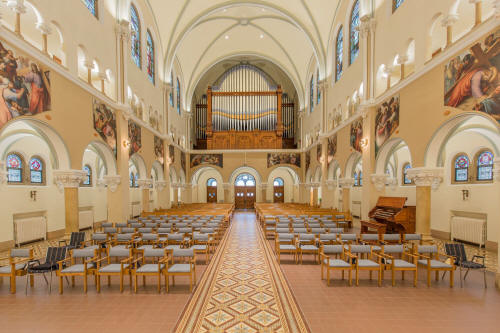|
Builder: Johnson & Son, Opus 499 (1877) Restorative repair: Dobson Organs (1995) Manuals: 3 Stops: 44 Ranks: 54 Action: Electro-pneumatic pulldowns on slider chests Notes: Photo by Len Lavasseur, 2016 1877 - Installed in St. Mary of the Sacred Heart Church, Boston 1922 - Electric action installed by W. W. Laws 1975 - Moved to the Chapel of the Motherhouse of the School Sisters of Notre Dame in Mankato by Richard Lurth 1995 - Restorative rebuild by Dobson Organ Co., including new wind system --Information from Dobson Organ Co, Mark Thompson, and Sister Janis Haustein. Last Update: 2/2014 GREAT ORGAN 16 Open Diapason 8 Open Diapason 8 Spitz Floete 8 Doppel Floete 4 Octave 4 Harmonic Flute 2-2/3 Twelfth 2 Fifteenth III Mixture IV Mixture 8 Trumpet (Johnson patent) 4 Clarion SWELL ORGAN 16 Bourdon 8 Open Diapason 8 Salicional 8 Stopped Diapason 8 Quintadena 4 Octave 4 Violin 4 Flauto Traverso 2 Flautino II Mixture III Mixture 16 Contra Fagotto 8 Cornopeon (Johnson patent) 8 Oboe 8 Vox Humana 4 ClarionSOLO ORGAN 16 Quintaton 8 Geigen Principal 8 Keraulophon 8 Dulciana 8 Melodia 4 Fugara 4 Flute d’Amour 2 Piccolo 8 Clarinet PEDAL ORGAN 16 Double Diapason 16 Bourdon 16 Violone 10-2/3 Quinte 8 Violoncello 16 Trombone 8 TrombaNotes from Dobson Organ Co. Anyone who undertakes the restoration of an historic organ is faced with choices. When the instrument has undergone major changes during its life, the picture is further clouded. Johnson & Son’s Op. 499, originally installed in 1877 in the Church of St. Mary of the Sacred Heart in Boston, had seen the removal of its original key action, stop action and wind system in 1927 by W. W. Laws. In 1974, the organ’s future was threatened by the impending demolition of St. Mary’s. Fortunately, a new home was found for the organ within the Chapel of Our Lady of Good Counsel at the Motherhouse of the School Sisters of Notre Dame in Mankato, Minnesota. Though considerably smaller in enclosed volume, the chapel has excellent acoustics and the organ fits the room both visually and aurally. The removal and reinstallation of the organ in 1975 was directed by Richard Lurth, who had the considerable assistance of the entire community during the project, washing pipes, rewiring and re-stenciling front pipesFaced with major repairs to the pneumatic actions, the School Sisters of Notre Dame selected our firm to perform restorative repairs to the organ. Because of the physical limitations of the balcony and the budget, reconstruction Johnson’s original action with its Barker machines was impossible. Therefore, we releathered the existing electro-pneumatic pulldown and stop actions, and supplied a modern solid state switching system. Spurious windchests and pipework in the Swell and Pedal were removed. We constructed a new console with liberal reference to existing Johnson examples, most notably that in Sacred Heart Church, Waterbury, Connecticut; like the case, the console is made of ash. Two new bellows, 72" x 114", were constructed, one for the Great and Pedal, the other for the Swell and Solo; a third, smaller reservoir was constructed to supply the pneumatic actions. Because there was no documentation of the layout of the original, a new wind system was freely laid out within the organ with no attempt made to replicate its original configuration save where the windlines entered the chests. Throughout, the guiding principle was to restore the lustre to Johnson’s original work, while accommodating the limitations imposed by the new physical situation and the funds available. The most significant survival from 1877 is the almost unaltered pipework. Especially noteworthy are the three “Johnson & Son Patent Reeds”: the Great Trumpet, the Swell Cornopeon and the Pedal Trombone. Every attempt was made to maintain the original voicing; where pipes were damaged, repairs were made in keeping with the originals. The organ retains its cone tuning, and is approximately one-quarter of a semitone sharp of modern pitch. The result is a sound that defies the stereotypical notions of 19th century century American organs. --Dobson Organs |
 |
| Notes from Mark Thompson. The large Johnson and Sons organ in the Good Counsel Chapel, rebuilt by Dobson,,,, is the largest surviving instrument by that firm. [There is] an LP made by Thomas Murray, the only recitalist to have played the instrument in both its original and present locations. It is definitely a child of its times, tonally, but it is an utterly magnificent organ in a splendid acoustic. The console was built by Dobson after surviving examples of Johnson consoles (the organ was a tracker, electrified in the late 1920s, and the man who moved it into the chapel originally used an old (and, by the time of the Dobson rebuild, truly decrepit) Austin console. The pipe stencilling was done by the Sisters to match the original | |